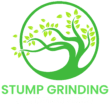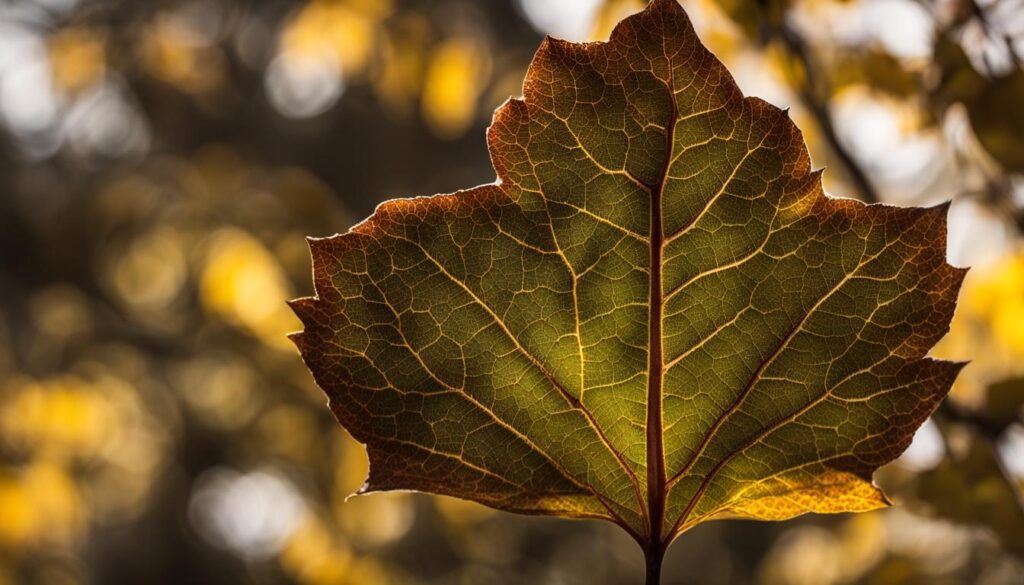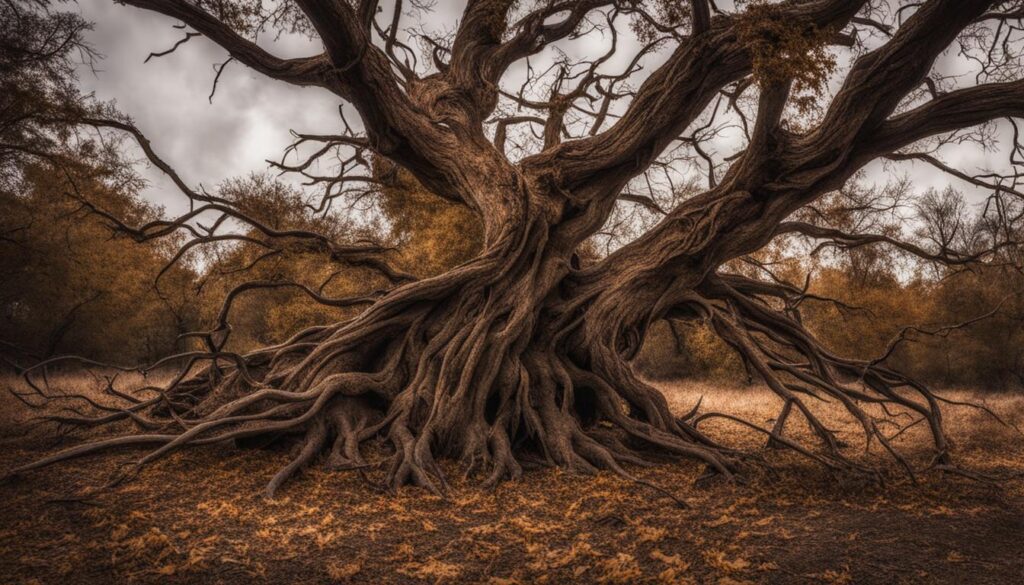Anthracnose is a group of fungal diseases that can cause dark lesions on leaves and cankers on twigs and stems. It affects many trees, shrubs, vegetables, flowers, fruit, and turfgrass. To effectively manage anthracnose, it is important to implement a combination of treatment and therapy strategies.
One of the key management strategies is careful disease management. This involves regularly monitoring plants for symptoms and taking prompt action. Selecting resistant varieties is another effective approach to minimize the risk of anthracnose. These varieties are bred to have greater tolerance and resilience against the disease.
Cultural practices play a crucial role in anthracnose control. Pruning infected branches, removing fallen leaves, and maximizing air circulation and sunlight can help create an unfavorable environment for the fungi to thrive. Additionally, implementing appropriate irrigation practices and avoiding excessive moisture can help prevent anthracnose development.
In some cases, the use of fungicides may be necessary to control severe anthracnose infections. There are various fungicides available that can effectively suppress the growth of the fungi. However, it is important to carefully follow the instructions for proper application and timing of fungicide treatments.
Professional treatments for anthracnose may be required in severe cases or for valuable landscape plants. Consulting with a qualified arborist or horticulturist can provide expert advice and guidance on the best treatment options for specific situations.
Key Takeaways:
- Implement a combination of treatment and therapy strategies for effective anthracnose management.
- Careful disease management, selecting resistant varieties, and cultural practices are important for controlling anthracnose.
- Fungicides may be necessary in severe cases, but proper application and timing are crucial.
- Consult with a professional for expert advice on treatment options.
- Regular monitoring and prompt action can help prevent and manage anthracnose effectively.
Anthracnose Identification and Damage
Anthracnose is a fungal disease that can cause significant damage to plants. Identifying anthracnose early is crucial for effective management and preventing further spread.
Symptoms of anthracnose can vary depending on the plant host and weather conditions. Common indicators of anthracnose include:
- Leaf spots: Dark, sunken lesions on leaves that may grow in size and develop a concentric ring pattern.
- Cankers: Sunken areas on twigs and stems that can lead to dieback and affect the overall health of the plant.
- Curled and distorted leaves: Infected leaves may become misshapen, curled, or exhibit abnormal growth patterns.
- Defoliation: In severe cases, leaves may defoliate starting from the lower parts of the plant.
In some plants, such as trees, anthracnose can also cause branch dieback and trunk cankers, impacting the structural integrity of the plant.
Proper identification of anthracnose symptoms is essential for implementing appropriate management strategies. In the next section, we will explore effective anthracnose management strategies to minimize damage and prevent further spread of this fungal disease.
Anthracnose Life Cycle
Anthracnose Life Cycle
Anthracnose fungi are known to primarily infect leaves and twigs. Understanding the life cycle of anthracnose is crucial in combatting this common fungal infection. In spring, microscopic spores are produced and spread through rain or irrigation water. These spores can be carried by wind or splashing raindrops onto nearby plant surfaces, facilitating their germination and entry into leaves and newly expanded twigs.
Once inside the host plant, the fungal spores undergo a complex process of germination, penetrating the plant tissues. This penetration leads to the development of characteristic symptoms associated with anthracnose fungal infection. The infection often manifests as dark lesions on leaves and cankers on twigs and stems, compromising the overall health and vitality of the plant.
The anthracnose life cycle continues as the infected plant tissues produce a successive generation of spores if weather conditions and other factors favor their growth and reproduction. These new spores are then spread to other plant parts or adjacent plants, perpetuating the cycle of infection.
It is important to note that the progression of the anthracnose life cycle can vary depending on environmental conditions. During hot and dry weather, the disease activity tends to slow down. However, when conditions become favorable again, such as increased humidity or extended periods of rain, the cycle resumes, leading to the further spread and development of anthracnose infections.
To better understand the anthracnose life cycle and its impact on plants, refer to the image below:
By gaining insights into the mechanisms underlying anthracnose fungal infection and spore production, we can implement effective strategies to control and prevent this destructive disease.
Anthracnose Management Strategies
Effective management of anthracnose involves a combination of strategies to control and prevent the spread of the disease. By implementing cultural practices and selecting resistant varieties, you can effectively manage anthracnose in your plants.
Selecting Resistant Varieties
One of the key strategies in anthracnose management is to choose plant varieties that have resistance to the disease. Resistant varieties have been specifically bred to withstand anthracnose infections. For example, Moraine, Raywood, and Evergreen Ash varieties are resistant to anthracnose and are suitable for ash trees. The Drake variety is resistant to anthracnose and is a good choice for Chinese elm.
Implementing Cultural Practices
Cultural practices play an important role in preventing and managing anthracnose. Pruning infected branches is essential to remove the source of the disease. It is important to prune during dry weather to minimize the risk of spreading the fungal spores. Additionally, removing fallen leaves and disposing of them properly helps to reduce the spread of anthracnose. Maximizing air circulation and sunlight by pruning to create a more open canopy also helps to keep the foliage dry, reducing the favorable conditions for anthracnose.
Monitoring Environmental Conditions
Monitoring environmental conditions is crucial in managing anthracnose. Anthracnose thrives in moist environments, so it’s important to avoid overwatering and to provide proper drainage. Regularly check for signs of anthracnose, such as leaf spots and cankers, and take appropriate actions promptly. By staying vigilant and monitoring the weather patterns, you can implement preventive measures before the disease becomes severe.
Chemical Control of Anthracnose
When it comes to managing anthracnose infections, chemical control can be an effective strategy. However, it’s important to note that fungicides do not eliminate existing infections but can help prevent future ones. To effectively control anthracnose, fungicides containing chlorothalonil, copper, propiconazole, and thiophanate-methyl have shown effectiveness.
Proper spray coverage and timing are crucial for achieving successful control of anthracnose. It’s essential to ensure that the entire plant is covered with the fungicide spray, including the foliage, twigs, and stems. Additionally, timing the application according to the disease cycle and environmental conditions is key to maximizing effectiveness.
However, it’s important to note that fungicide applications may not be necessary for all situations. The effectiveness of fungicides can vary depending on the tree species, so it’s crucial to consider the specific needs and characteristics of the affected plants.
Anthracnose Resistance and Breeding
Breeding for anthracnose resistance is crucial for effectively managing this fungal disease in the long term. To develop resistant varieties, both conventional breeding and genomics-assisted breeding techniques have been utilized. However, the emergence of new and more virulent strains of anthracnose pathogens necessitates the development of improved varieties with broad-spectrum and durable resistance.
Conventional breeding methods involve selecting and crossbreeding plants with desirable resistance traits. This process involves carefully evaluating the resistance levels of various plant genotypes and selecting those with the highest resistance.
Genomics-assisted breeding, on the other hand, combines traditional breeding techniques with advanced genomic technologies. By analyzing the genetic composition of anthracnose-resistant plants, researchers can identify genes responsible for resistance. This knowledge can then be used to develop molecular markers, allowing breeders to efficiently select plants with the desired resistance traits.
Furthermore, biotechnological techniques such as genetic engineering and CRISPR/Cas9 genome editing can complement traditional breeding methods. These techniques enable scientists to introduce specific resistance genes into plant genomes or modify existing genes, accelerating the process of crop improvement.
Yam Anthracnose Control
Yam anthracnose, caused by Colletotrichum alatae, is a devastating fungal disease that poses a significant threat to yam crops. This disease leads to substantial yield losses, affecting food security and livelihoods.
Traditional methods and fungicides have had limited success in controlling yam anthracnose. Therefore, alternative approaches, such as breeding for resistance, are crucial for effective disease management.
Yam Anthracnose Resistance Breeding
Breeding for resistance to anthracnose in yam is essential to combat this destructive disease. Through extensive research and development efforts, new yam varieties with enhanced resistance to anthracnose can be developed, ensuring the long-term sustainability of yam production.
Genomics-assisted breeding techniques play a pivotal role in accelerating the development of anthracnose-resistant yam varieties. By leveraging genetic information, breeders can identify and incorporate genes conferring resistance into breeding programs more efficiently and accurately.
In addition, advanced biotechnological techniques, such as genetic engineering and CRISPR/Cas9 genome editing, offer promising avenues for enhancing anthracnose resistance in yam. These cutting-edge tools enable scientists to precisely manipulate the plant’s genes, enhancing its resilience against the disease.
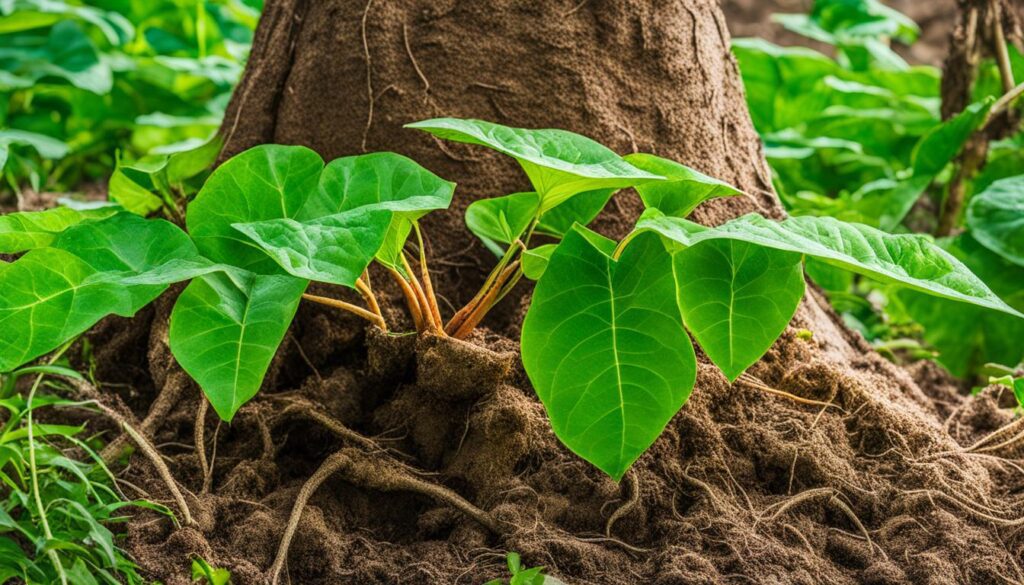

By combining traditional breeding methods with genomics-assisted techniques and biotechnological approaches, researchers and breeders can expedite the development of anthracnose-resistant yam varieties. This approach is crucial in safeguarding yam production, ensuring sustainable food production, and supporting agricultural communities.
Anthracnose in Trees: Cause and Symptoms
Anthracnose in trees is a common fungal disease that can quickly spread in damp or windy weather conditions. It primarily affects leaf-shedding species, including oak, maple, dogwood, sycamore, and walnut. Understanding the cause and symptoms of anthracnose is crucial for effective management and prevention of this disease.
One of the main causes of anthracnose in trees is fungal infection. The fungi responsible for anthracnose thrive in moist environments and can be easily spread through rain or wind. When the weather conditions are favorable, the fungus infects the leaves and stems of susceptible trees.
The symptoms of anthracnose vary depending on the tree species and the severity of the infection. One common symptom is the presence of leaf spots, which appear as small, dark lesions on the leaves. These spots can later expand and merge, leading to defoliation and reduced growth of the tree.
In addition to leaf spots, anthracnose can cause various leaf defects and discolorations. Leaves may become distorted, curled, or develop irregular shapes. Premature leaf shedding is another symptom of anthracnose in trees, which can further weaken the tree’s overall health.
To accurately diagnose anthracnose in trees, it is important to consider the combination of symptoms present, as well as the specific tree species affected. Identifying the disease early on can help implement appropriate management strategies and prevent further spread.
Treating Anthracnose in Trees
To effectively treat anthracnose in trees, it is essential to implement proper management practices. One of the key approaches is pruning during the winter months when the disease is dormant. Pruning helps improve air circulation, allowing sunlight to penetrate the foliage and reduce moisture buildup. It is crucial to remove infected branches and twigs, as they can serve as a source of fungal spores for further infection.
However, it’s important to note that pruning alone is not sufficient to eliminate anthracnose completely. Additional measures may be necessary to preserve the health of the trees and prevent the spread of the disease.
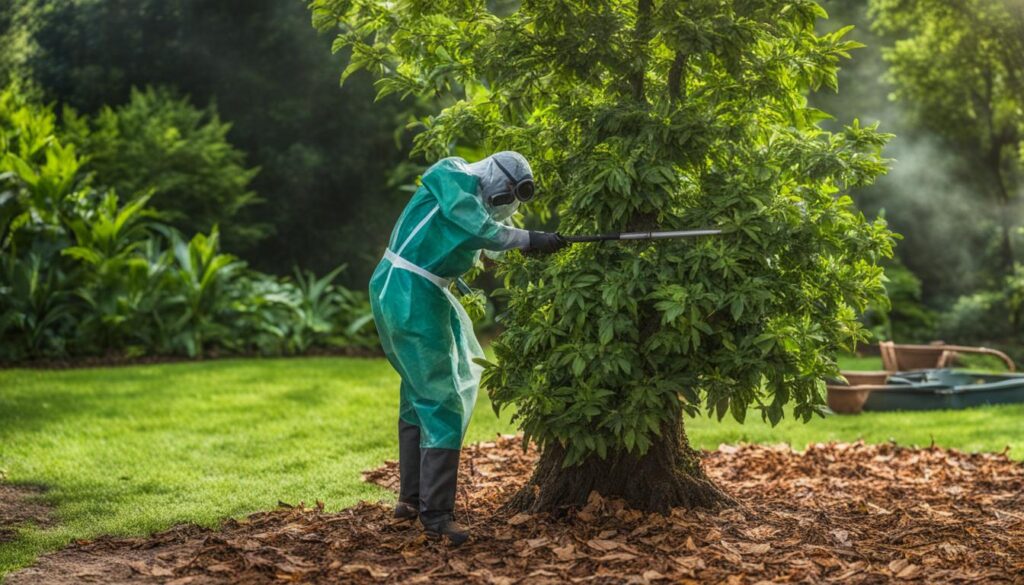

When it comes to preserving healthy trees and limbs, fungicides can be used as a preventive measure. These treatments can help suppress the development of anthracnose and protect against further infection. Fungicides containing active ingredients such as chlorothalonil, copper, propiconazole, or thiophanate-methyl have shown effectiveness in controlling anthracnose.
It is important to follow the instructions provided by manufacturers regarding the application and dosage of fungicides. Proper spray coverage and timing are crucial factors in ensuring the effectiveness of the treatment. Regular monitoring of the trees for any signs of re-infection is also recommended to take appropriate action promptly.
However, it is essential to understand that fungicide applications do not completely eliminate anthracnose and should be used in combination with other management strategies.
To further manage anthracnose, it is crucial to remove dead leaves and branches from the vicinity of the trees. Dead plant material can serve as a food source and breeding ground for the fungi causing anthracnose. Additionally, providing adequate spacing between trees and ensuring good air circulation can help reduce the favorable conditions for fungal growth and minimize the risk of infection.
Excessive moisture, such as over-irrigation or poor drainage, can contribute to the spread of anthracnose. It is important to water the trees appropriately and avoid creating a damp environment that promotes fungal development. Implementation of proper watering practices, such as watering early in the day, can help prevent prolonged leaf wetness and reduce the risk of infection.
By combining pruning, fungicide treatments, removal of dead plant material, and managing moisture levels, it is possible to effectively treat anthracnose in trees. These strategies play a vital role in minimizing the impact of the disease and preserving the health and aesthetics of our valuable tree populations.
Conclusion
After careful consideration of the various aspects of anthracnose management, it is evident that effective treatment and therapy involve a comprehensive approach. By implementing careful management practices, such as pruning infected branches and removing fallen leaves, we can limit the severity of anthracnose infections. Additionally, selecting resistant varieties, such as Moraine, Raywood, Evergreen Ash, and Drake, can provide an added layer of protection against this fungal disease.
Regular monitoring of environmental conditions is crucial for early detection and prompt action. By keeping a close eye on weather patterns and the overall health of plants, we can identify and address anthracnose issues before they become severe. When necessary, the judicious use of fungicides containing chlorothalonil, copper, propiconazole, or thiophanate-methyl can provide effective control.
In conclusion, by combining careful management techniques, cultural practices, selection of resistant varieties, and targeted fungicide use, we can effectively prevent, manage, and minimize the impact of anthracnose in our gardens and landscapes. With regular attention and proactive measures, we can ensure the health and vitality of our plants, promoting thriving environments for years to come.
FAQ
What is anthracnose?
Anthracnose is a group of fungal diseases that can cause dark lesions on leaves and cankers on twigs and stems. It affects many trees, shrubs, vegetables, flowers, fruit, and turfgrass.
What are the symptoms of anthracnose?
Symptoms of anthracnose vary depending on the plant host and weather conditions. They may include black leaf spots, sunken lesions, and cankers on twigs and stems. Leaves can become curled, distorted, and may defoliate from the ground up. Severe cases can lead to branch dieback and trunk cankers.
How does anthracnose spread?
Anthracnose fungi primarily infect leaves and twigs. In spring, microscopic spores are produced and spread via rain or irrigation water. The spores germinate and enter leaves and newly expanded twigs. A successive generation of spores can be produced if conditions are favorable. The disease slows down during hot, dry weather.
How can anthracnose be managed?
Effective management of anthracnose involves selecting resistant varieties, implementing cultural practices such as pruning and sanitation, and monitoring environmental conditions. Resistant varieties include Moraine, Raywood, and Evergreen Ash for ash trees, and Drake for Chinese elm. Cultural practices include pruning infected branches, removing fallen leaves, and maximizing air circulation and sunlight.
Are there any fungicides for anthracnose control?
Yes, some fungicides can be used to prevent anthracnose infections. However, fungicides do not eliminate existing infections. Fungicides containing chlorothalonil, copper, propiconazole, and thiophanate-methyl have been shown to be effective for control. Proper spray coverage and timing are crucial for successful control. However, fungicide applications may not be necessary for all situations, and their efficacy may vary depending on the tree species.
How can anthracnose resistance be developed?
Breeding for anthracnose resistance is an important strategy for long-term management. Conventional breeding and genomics-assisted breeding have been used to develop resistant varieties. Biotechnological techniques, such as genetic engineering and CRISPR/Cas9 genome editing, can complement traditional breeding methods to speed up crop improvement.
How can yam anthracnose be controlled?
Yam anthracnose, caused by Colletotrichum alatae, is a devastating fungal disease. Traditional methods and fungicides have had limited success in controlling the disease. Breeding for resistance to anthracnose is crucial for food security. Genomics-assisted breeding, genetic engineering, and CRISPR/Cas9 genome editing can be used to develop anthracnose-resistant yam varieties.
What trees are susceptible to anthracnose?
Anthracnose in trees commonly affects leaf-shedding species such as oak, maple, dogwood, sycamore, and walnut. The symptoms include leaf spots, reduced growth, premature leaf shedding, and various leaf defects and discolorations.
How can anthracnose in trees be treated?
Treating anthracnose in trees involves pruning in winter to improve circulation and remove infected branches. Fungicides may be used to preserve healthy trees and limbs, but they do not eliminate anthracnose. It is important to remove dead leaves and branches and avoid excessive moisture to prevent further spread of the disease.
What is the key to effective anthracnose treatment?
Effective anthracnose treatment and therapy involve a combination of careful management, cultural practices, selection of resistant varieties, and, when necessary, the use of fungicides. Regular monitoring of environmental conditions and prompt action can help prevent and manage anthracnose in plants, ensuring the health and vitality of gardens and landscapes.
